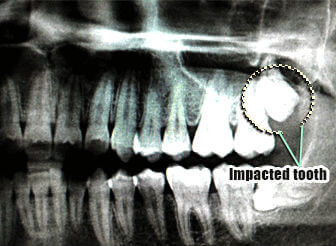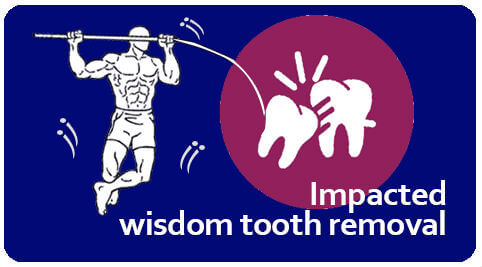Wisdom teeth
What are Wisdom teeth?
Wisdom teeth are the third and final set of molars that most people get in their late teens or early twenties (17-25 years). Most adults have four wisdom teeth, one in each of the four quadrants, These teeth in some individuals are misaligned (Impacted teeth) and require removal.
What are the problems associated with misaligned wisdom teeth?
When wisdom teeth are misaligned, they may position themselves horizontally, be angled toward or away from the second molars, or be angled inward or outward. Poor alignment of wisdom teeth can crowd or damage adjacent teeth, the jawbone, or nerves. Sometimes they are enclosed within the soft tissue and/or the jawbone or only partially break through or erupt through the gum.
Why should the wisdom teeth be removed?

The partial eruption of the wisdom teeth allows an opening for bacteria to enter around the tooth and cause an infection, which results in pain, swelling, jaw stiffness, and general illness. Partially erupted teeth are also more prone to tooth decay and gum disease because their hard-to-reach location and awkward positioning makes brushing and flossing difficult. As mentioned earlier they also must be removed if they are causing damage to adjacent teeth or causing pain due to pressure on the nerve.
How to know if the wisdom teeth are impacted or not?
Regular periodic dental checkup and x-ray evaluation by the dentist helps in determining whether the wisdom teeth are impacted or in a normal position.
What is the ideal age to get the impacted teeth removed?
Impacted teeth are removed when they are diagnosed and they are causing the problems like adjacent tooth damage or gum infections.
Sometimes the dentist or oral surgeon may recommend the impacted teeth to be removed even before problems develop. This is done to avoid a more painful or more complicated extraction that might have to be done a few years later.
Removal is easier in young people when the wisdom teeth roots are not yet fully developed and the bone is less dense. In older people, recovery and healing time tend to be longer. So it is ideal and easier to get the impacted teeth removed at a young age.
How Are Wisdom Teeth Removed?

The relative ease at which your dentist or oral surgeon can extract your wisdom teeth depends on their position and stage of development.
A wisdom tooth that is underneath the gums and embedded in the jawbone will require a nick into the gums and then removal of the portion of bone that lies over the tooth.
Often, for a tooth in this situation, the tooth will be extracted in small sections rather than removed in one piece to minimize the amount of bone that needs to be removed to get the tooth out.
What Happens During Wisdom Teeth Removal?
Before extraction of the impacted tooth wisdom, the teeth and the surrounding tissue will be numbed with a local anesthetic.
In most patients, the procedure of removing the impacted teeth is carried out under local anesthesia.
But, in cases where the extraction of the impacted teeth is anticipated to be difficult or when the impacted teeth are completely buried in the bone requiring extensive surgery, then a procedure under general anesthesia is carried out.
For such cases, the procedure is planned priorly and patients are asked to take nothing by mouth at least 6 hours before the procedure.
What Does Recovery Involve After Wisdom Teeth Are Pulled?
After having your wisdom teeth removed, the speed of recovery depends on the degree of difficulty of the extraction (a simple extraction of a fully erupted tooth versus a tooth impacted into the jawbone).
The general consequences are as follows:
During the first 24 hours
- Bleeding may occur for several hours after tooth extraction. To control it, position a piece of clean moist gauze over the empty tooth socket and bite down firmly. Apply constant pressure for about 45 minutes.
- If heavy bleeding continues to occur, contact your dentist or oral surgeon.
- Avoid rinsing or spitting for 24 hours after tooth extraction, avoid “sucking” actions (for example, don’t drink beverages through straws or smoke) and avoid hot liquids (such as coffee or soup). These activities can dislodge the clot, causing a dry socket to develop.
- Facial swelling in the area where the tooth was extracted typically occurs. To minimize swelling, place a piece of ice, wrapped in a cloth, on that area of your face on a schedule of 10 minutes on, followed by 20 minutes off. Repeat as necessary during this first 24-hour period.
- Pain medications, such as paracetamol can be taken for minor pain. Your dentist or oral surgeon may prescribe more potent pain relievers, if necessary.
- Antibiotics that may have been prescribed prior to tooth extraction (to treat any active infection around the wisdom tooth to be extracted) should continue to be taken until the full prescription is gone.
- Foods should be restricted to a liquid diet until all the numbness from anesthesia has worn off. Only Soft foods should be taken for a few days. Also, the patients should avoid alcohol until further orders are given by the dentist/ oral surgeon.
- Patients can continue to brush their teeth, but avoid the teeth directly neighboring the extracted tooth during the first 24 hours. On day two, they can resume gentle brushing of their teeth. commercial mouth rinses which can irritate the extraction site should not be used.
After 24 hours
- Facial swelling in the area of the tooth extraction should be treated with heat after the first 24 hours of ice. A moist warm towel should be applied to the area on a 20-minute on, 20-minute off schedule.
- Rinsing the mouth with warm salt water (1/2 teaspoon of salt in a cup of warm water) after meals and before bed is recommended.
- Stitches, if used and if not of the self-dissolving type, need to be removed by the dentist in about 1 week.
- Complete healing doesn’t occur for a few weeks to a few months following the extraction. However, usually within the first week or two, enough healing has taken place for use of your mouth to be reasonably comfortable in the area of the extraction. Your dentist will explain what to expect in your specific case.
What Are Potential Complications of Impacted Tooth Removal?
Two of the more important complications after having removal of impacted teeth are :
- Dry socket. Dry socket is a common complication that occurs when either a blood clot has failed to form in the extracted tooth socket or else the blood clot that did form has been dislodged.
- Without clot formation, healing will be delayed. When it happens, dry socket typically occurs 3 or 4 days following the extraction and is accompanied by pain (ranging from “dull” to “moderate” to “severe”) and a foul mouth odour. Dentist / oral surgeon will treat the dry socket by placing the medication in the socket.
- Paresthesia. Paresthesia is a rarer complication of impacted teeth extraction. Impacted teeth deeply embedded in the jawbone are often close to nerves. Sometimes these nerves can be bruised or damaged during the tooth removal process. The result is a numbness (called a paresthesia) of the tongue, lip, or chin that can last a few days, weeks, months, or may even be permanent.

